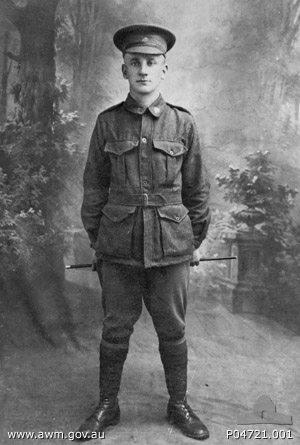Pte
William Anderson
Informations sur naissance
|
Année de naissance: 1896 |
|
Lieu de naissance: Saltcoats, Ayrshire, Écosse, Royaume-Uni |
Informations générales
|
Profession: Clerk |
Informations service militaire
|
Pays: Australia |
|
Force armée: Australian Imperial Force |
|
Rang: Private |
|
Numéro de service: 807B |
|
Incorporation date: 31/01/1916 |
|
Incorporation nom de lieu: Surrey Hills, Victoria, Australia |
|
Unités: — Australian Infantry, 5th Bn. (Dernière unité connue) — Australian Infantry, 37th Bn. |
Informations sur décès
|
Date de décès: 04/10/1917 |
|
Lieu de décès: Garter Point, Zonnebeke, Belgique |
|
Cause du décès: Killed in action (K.I.A.) |
|
Âge: 21 |
Mémorial
|
Ypres (Menin Gate) Memorial Panneau: 7 |
Distinctions et médailles 2
|
British War Medal Médaille |
|
Victory Medal Médaille |
Points d'intérêt 3
| #1 | Lieu de naissance | ||
| #2 | Lieu d'enrôlement | ||
| #3 | Lieu du décès (approximatif) |
Mon histoire
On the 4th of October, the Battle of Broodseinde was fought. The 2nd Australian Infantry Brigade carried out a mission, with the goal to capture the positions of the enemy as far as the Line Celtic (D.29.d.40.45.) to D.29.b.10.60.. The objectives were the red and blue line. The 8th Bn. A.I.F. had to get to the red line, the 6th and 7th Bn. A.I.F. had to reach the blue line. The 5th Bn. A.I.F. was in reserve. At midnight on the night of the 3rd/4th October, the locations of the various units were as followed: the Brigade headquarters were located at Westhoek Ridge (J1.d.75.10), the 5th Bn. A.I.F. was positioned at the Front Line, with headquarters at J.7.b.6.5., the 6th Bn. A.I.F. was located at Westhoek Ridge, with headquarters at J.7.b.6.8., the 7th Bn. A.I.F. found itself at Westhoek Ridge, with headquarters at J.7.b.5.5. and the 8th Bn. A.I.F. was positioned at Anzac Ridge with headquarters at J.9.a.6.5. The 8th Bn. A.I.F. reached the red line at 6.30 a.m. and advanced 100 yards beyond, to a position of better command and out of the enemy’s barrage, just behind and parallel to the Begelaere-Broodseinde Road, with points of the line touching the road. A hostile Battery was in position on this road just in front of the Line, but they were captured. The red line was consolidated by 7.30 a.m. The blue line was also captured and consolidated. Throughout the day and during the following night, the enemy’s shelling continued to be very severe over the whole captured area, on the old front line and in the valley rear thereof. Private William Anderson was killed while carrying ammunition during a counter attack around 3.30 p.m., when he was hit by a shell. He died at Garter Point (J.3 a.6.5.).
Sources 3
|
5th Australian Infantry Brigade, (Australian War Memorial, Campbell (AWM), AWM4 23/22/32). https://www.awm.gov.au/collection/C1338583 Sources utilisées |
|
First Australian Imperial Force Personnel Dossiers, 1914-1920 (National Archives of Australia, Canberra (NAA), B2455, ANDERSON W). https://recordsearch.naa.gov.au/SearchNRetrieve/Interface/SearchScreens/NameSearch.aspx Sources utilisées |
|
McCarthy, C., The Third Ypres Passchendaele. The Day-By-Day Account (London, Arms & Armour Press, 199, p. 99. Sources utilisées |
Complément d’informations 4
|
Commonwealth War Graves Commission Database https://www.cwgc.org/find-records/find-war-dead/casualty-details/1597407 |
|
Namenlijst (In Flanders Fields Museum) https://namenlijst.org/publicsearch/#/person/_id=2a269187-2b2b-49d1-be1d-8fe14a9b586c |
|
Lives of the First World War (Imperial War Museum) https://livesofthefirstworldwar.iwm.org.uk/lifestory/7322585 |
|
The AIF Project (UNSW Canberra) https://aif.adfa.edu.au/showPerson?pid=5441 |
